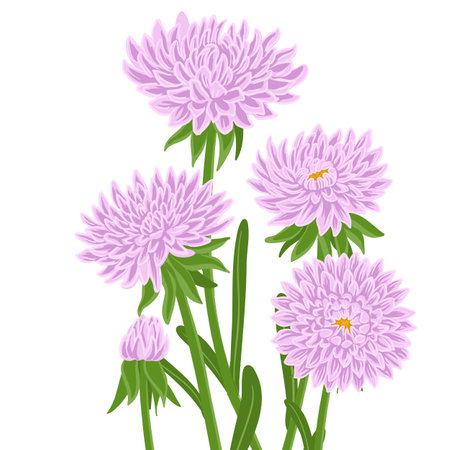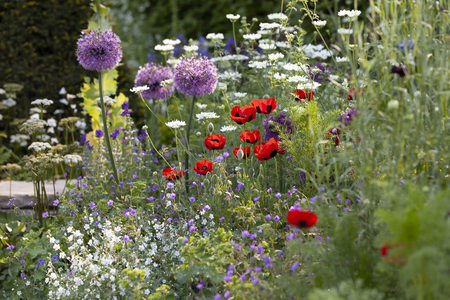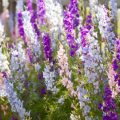Introduction to Perennial and Annual Flowers
In the world of British gardening, understanding the difference between perennial and annual flowers is essential for creating beautiful and lasting outdoor spaces. Perennials, often called “herbaceous perennials” in the UK, are plants that return year after year, typically flowering for several seasons. In contrast, annuals complete their life cycle within a single year, providing a burst of colour before dying back in autumn. Knowing these terms and how they apply to UK gardens helps gardeners choose the right plants for their borders, beds, and containers. Whether you are seeking long-term structure or vibrant seasonal displays, recognising the unique roles of perennials and annuals is the first step towards a thriving British garden.
Key Differences Between Perennials and Annuals
When planning a UK garden, understanding the differences between perennials and annuals is essential. These two types of flowers differ significantly in their life cycle, growth habits, and maintenance needs—especially as Britain’s seasons shift throughout the year.
Life Cycle Comparison
| Perennials | Annuals | |
|---|---|---|
| Duration | Live for several years, regrowing each spring | Complete their life cycle in one season |
| Bloom Period | Often bloom for a shorter period but return yearly | Provide vibrant colour all summer but die after frost |
Growth Habits in the UK Climate
Perennial plants are well-suited to the UKs temperate climate. They survive through winter by dying back to their roots or remaining evergreen, depending on the species. Annuals, meanwhile, thrive during the warmer months and rely on seed production for future growth. The unpredictable British weather can influence both types: perennials may require mulching to protect roots from frost, while annuals need to be planted after the last spring frost for best results.
Maintenance Requirements
| Perennials | Annuals | |
|---|---|---|
| Planting Frequency | Once, then enjoy for years with occasional dividing or replanting | Every year; sow seeds or plant new plugs each spring |
| Care Level | Low to moderate – regular deadheading and seasonal pruning help maintain shape and encourage blooms | Moderate – frequent watering, feeding, and deadheading keep displays at their best until autumn |
The Influence of UK Seasons
The UKs cool springs, mild summers, and damp autumns shape how both perennials and annuals perform. Perennials may go dormant during harsh winters but reward gardeners with early spring shoots. Annuals excel at filling gaps and providing instant impact during the brighter months. By understanding these key differences, you can select flowers that suit your gardening style and make the most of every season.

3. Popular Perennials in UK Gardens
Perennial flowers hold a special place in British gardens, appreciated for both their beauty and practicality. Many UK gardeners are drawn to perennials because they return year after year, reducing the need for frequent replanting and offering long-term value. This enduring nature makes them a sustainable choice that aligns well with the British love for tradition and low-maintenance gardening.
From an aesthetic perspective, perennials contribute to the classic charm of cottage gardens and formal borders alike. Their varied shapes, colours, and blooming periods create interest throughout the seasons. For example, lavender is prized not only for its fragrant purple spikes but also for attracting pollinators like bees—a vital part of supporting local biodiversity. Lavender’s drought tolerance also suits the unpredictable British weather.
Another favourite is the foxglove, known for its tall spires of bell-shaped flowers that add vertical drama to shady corners or wildflower areas. Foxgloves evoke quintessential English garden style and thrive in many parts of the UK, making them a reliable choice for both novice and experienced gardeners.
The resilient hardy geranium, often called cranesbill, is valued for its ability to flourish in a range of conditions—from sun-drenched spots to partially shaded beds. Its delicate blooms and mounding foliage provide a soft, natural look that complements both modern and traditional landscapes.
Together, these perennials not only offer lasting beauty but also practical benefits such as easy maintenance, wildlife support, and adaptability to the UK’s unique climate. This combination of aesthetics and functionality explains why perennials remain a cornerstone of British garden design.
4. Popular Annuals for British Gardeners
Annual flowers play a vital role in the dynamic and colourful look of many UK gardens. British gardeners often choose annuals for their ability to deliver instant, vibrant displays throughout spring and summer. These plants complete their life cycle within one growing season, making them perfect for adding seasonal variety to beds, borders, hanging baskets, and containers. Here are some of the most beloved annuals that thrive in the UKs climate:
Pansies
Pansies are a staple in British gardens thanks to their cheerful faces and wide range of colours. They are especially valued for their ability to bloom early in the year, sometimes even when there is still a chill in the air. Pansies do well in both beds and pots, offering flexibility for different garden styles.
Marigolds
Marigolds are celebrated for their bold yellows and oranges, which bring warmth to any outdoor space. Their strong scent also helps deter common garden pests, making them a practical as well as decorative choice. Marigolds thrive in full sun and are particularly popular in cottage gardens and allotments.
Sweet Peas
Sweet peas are loved for their delicate appearance and wonderfully sweet fragrance. These climbing annuals are ideal for training up trellises or obelisks, adding height and scent to borders or patios. Sweet peas are a traditional favourite at many British flower shows and can be cut for indoor arrangements.
Comparison Table: Popular Annuals at a Glance
| Annual Flower | Main Colours | Bloom Time | Ideal Use | Special Features |
|---|---|---|---|---|
| Pansy | Purple, yellow, white, blue | Spring–early summer | Beds, pots, window boxes | Tolerates cool weather |
| Marigold | Yellow, orange, red | Summer–autumn | Borders, vegetable patches | Pest deterrent |
| Sweet Pea | Pinks, purples, white, blue | Late spring–summer | Trellis, fences, cutting gardens | Scented blooms; climbing habit |
Choosing Annuals for Your Garden Design
Selecting the right annuals allows you to refresh your garden’s look each year while enjoying a succession of blooms from spring through autumn. Whether you favour classic pansies for early interest or fragrant sweet peas for summer charm, incorporating annuals is an easy way to achieve a vibrant and ever-changing display suited to British tastes and climate.
5. Best Uses in Garden Design
In the UK, both perennial and annual flowers play essential roles in garden design, each bringing unique qualities to various settings. Cottage gardens are a classic British style where perennials like lupins, delphiniums, and foxgloves create a timeless, romantic look with layers of colour and texture that return year after year. Annuals such as cosmos and sweet peas are often used to fill gaps or add bursts of seasonal colour, keeping the garden lively from spring through autumn.
For garden borders, perennials form the backbone thanks to their structure and reliability. Plants like geraniums, asters, and peonies provide long-lasting interest. Annuals, including marigolds or petunias, can be woven in at the front of borders for quick results and changing themes each season. This blend ensures your borders have both stability and variety.
Hanging baskets and containers are particularly popular in urban UK gardens or on patios where space is limited. Here, annuals like lobelia, begonias, and fuchsias shine with their vibrant blooms and trailing habits, delivering instant impact. While perennials are less commonly used in baskets due to their longer life cycle and growth habits, some compact varieties such as heucheras can provide lasting foliage interest if you prefer a lower-maintenance option.
Other spaces such as wildlife gardens benefit from native perennials like oxeye daisies or knapweed, which support pollinators year after year. Meanwhile, annual wildflower mixes create a meadow effect for one glorious summer display. By understanding the strengths of perennials and annuals, UK gardeners can craft beautiful, practical spaces that thrive throughout the seasons.
6. Planting and Care Tips for the UK Climate
Gardening in the UK means dealing with unpredictable weather, varying soil types, and changing light conditions. Here are some simple and effective tips to help your perennial and annual flowers thrive across the seasons.
Choosing the Right Spot
Most perennials and annuals enjoy a sunny spot, but always check the plant label. Many classic British favourites—like lavender or marigolds—love full sun, while woodland plants such as foxgloves prefer partial shade. Observe your garden throughout the day to find areas that match each flower’s needs.
Soil Preparation
The UKs soil varies from chalky in the south to clay-heavy in the Midlands and north. Before planting, dig in well-rotted compost or manure to improve drainage and boost nutrients. If you have heavy clay, consider raised beds or add grit to help roots breathe.
Watering Wisely
Rain is common, but dry spells do happen—especially in summer. Water newly planted annuals and perennials deeply once a week rather than little and often. Early morning is best, allowing leaves to dry off quickly and preventing fungal issues.
Feeding Your Flowers
Annuals, like bedding plants, benefit from regular feeding with a balanced liquid fertiliser every two weeks during their growing season. Perennials need less frequent feeding; a slow-release fertiliser applied in spring will support steady growth without encouraging weak stems.
Mulching Matters
A mulch of bark or compost helps retain moisture, suppress weeds, and insulate roots through cold snaps—a wise move for both annuals and perennials in British gardens.
Protecting Against Frost
The UK climate brings late frosts even in May. For tender annuals, wait until all danger of frost has passed before planting out. Mulch perennials or cover with fleece if temperatures are set to dip suddenly.
Deadheading and Pruning
Regular deadheading encourages more blooms on both plant types. For perennials, cutting back after flowering keeps borders tidy and sometimes leads to a second flush later in summer.
By tailoring your care routine to local conditions, you’ll enjoy healthy plants and colourful displays from spring through autumn—whatever the British weather brings.
7. Sustainability and Wildlife Benefits
When choosing flowers for your UK garden, its important to consider their impact on the environment and local wildlife. Perennial and annual flowers each offer unique benefits that can help create a more sustainable and wildlife-friendly outdoor space.
The Environmental Impact of Perennials and Annuals
Perennials are often seen as the more eco-friendly choice because they return year after year, reducing the need for frequent replanting and minimising soil disturbance. This also means less use of plastic pots and packaging. Annuals, while adding instant colour and variety, require replanting each season, which can lead to more resource use over time.
Supporting Pollinators in the UK
Both perennials and annuals play vital roles in supporting pollinators like bees, butterflies, and hoverflies. Native perennials such as foxgloves, primroses, and lavender provide reliable sources of nectar throughout the growing season. Many annuals—like cornflowers and sunflowers—also attract pollinators, making them valuable additions to pollinator-friendly gardens.
Making Eco-Friendly Choices
To maximise sustainability, consider mixing hardy native perennials with carefully chosen annuals that benefit wildlife. Avoid using pesticides or peat-based composts, and look for plants grown locally to reduce your carbon footprint. By thoughtfully selecting your garden plants, you’ll not only create a beautiful outdoor space but also contribute positively to the UK’s natural ecosystem.


